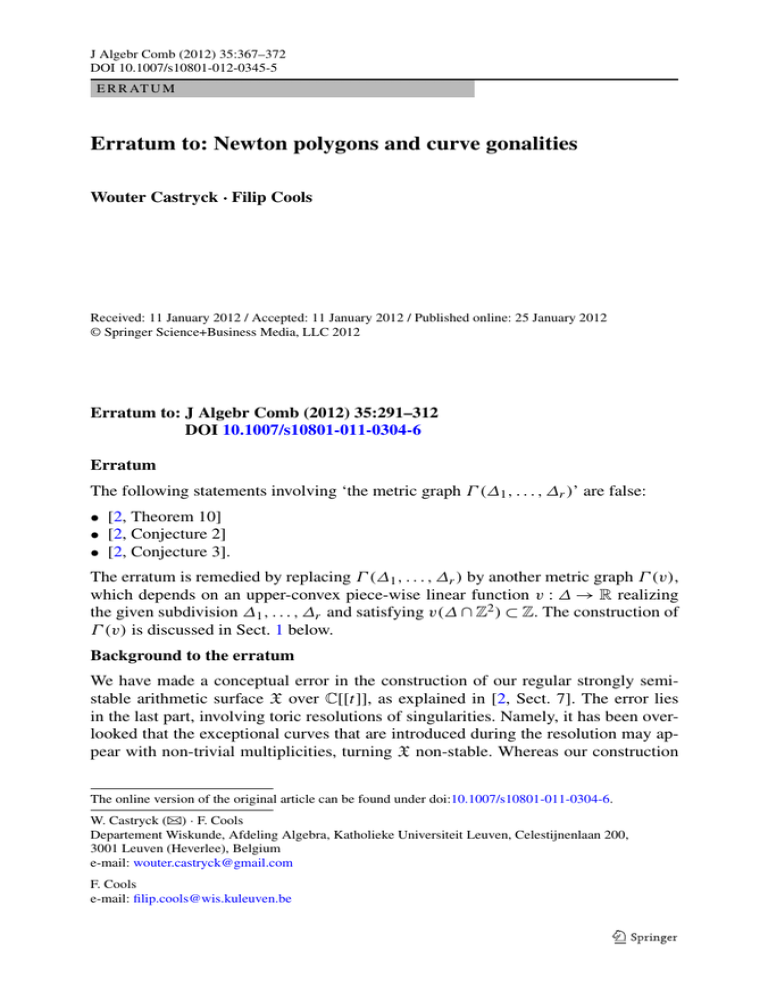Erratum to: Newton polygons and curve gonalities Wouter Castryck · Filip Cools
advertisement

J Algebr Comb (2012) 35:367–372
DOI 10.1007/s10801-012-0345-5
E R R AT U M
Erratum to: Newton polygons and curve gonalities
Wouter Castryck · Filip Cools
Received: 11 January 2012 / Accepted: 11 January 2012 / Published online: 25 January 2012
© Springer Science+Business Media, LLC 2012
Erratum to: J Algebr Comb (2012) 35:291–312
DOI 10.1007/s10801-011-0304-6
Erratum
The following statements involving ‘the metric graph Γ (Δ1 , . . . , Δr )’ are false:
• [2, Theorem 10]
• [2, Conjecture 2]
• [2, Conjecture 3].
The erratum is remedied by replacing Γ (Δ1 , . . . , Δr ) by another metric graph Γ (v),
which depends on an upper-convex piece-wise linear function v : Δ → R realizing
the given subdivision Δ1 , . . . , Δr and satisfying v(Δ ∩ Z2 ) ⊂ Z. The construction of
Γ (v) is discussed in Sect. 1 below.
Background to the erratum
We have made a conceptual error in the construction of our regular strongly semistable arithmetic surface X over C[[t]], as explained in [2, Sect. 7]. The error lies
in the last part, involving toric resolutions of singularities. Namely, it has been overlooked that the exceptional curves that are introduced during the resolution may appear with non-trivial multiplicities, turning X non-stable. Whereas our construction
The online version of the original article can be found under doi:10.1007/s10801-011-0304-6.
W. Castryck () · F. Cools
Departement Wiskunde, Afdeling Algebra, Katholieke Universiteit Leuven, Celestijnenlaan 200,
3001 Leuven (Heverlee), Belgium
e-mail: wouter.castryck@gmail.com
F. Cools
e-mail: filip.cools@wis.kuleuven.be
368
J Algebr Comb (2012) 35:367–372
suggested that one can keep blowing up to an arbitrary extent, one should be much
more careful and blow up just the ‘right’ number of times:
• all singularities should become resolved (enough blow-ups),
• no non-trivial multiplicities should appear (not too many blow-ups).
Luckily, this ‘right’ number always exists and can be controlled in a purely combinatorial way.
1 The graph Γ (v)
Let Δ ⊂ R2 be a two-dimensional lattice polygon. Let Δ1 , . . . , Δr ⊂ Δ be a regular
subdivision and let v : Δ → R be an upper-convex piece-wise linear function realizing this subdivision. Assume that v(Δ ∩ Z2 ) ⊂ Z. Let G(Δ1 , . . . , Δr ) be the graph
with vertex set {v1 , . . . , vr } such that for all , m the number of edges between v
and vm is equal to the integral length L(, m) of Δ ∩ Δm (i.e. the number of lattice
points minus one).
Let G(v) be obtained from G(Δ1 , . . . , Δr ) by replacing each such edge with a
linear graph of length d(, m). Here, d(, m) is the greatest common divisor of the
(2 × 2)-minors of
a1 a2 1
,
am1 am2 1
where (a1 , a2 , 1) and (am1 , am2 , 1) are primitive normal vectors to the graphs of v
restricted to Δ and Δm , respectively. The third coordinate can be taken 1 because
v(Δ ∩ Z2 ) ⊂ Z.
Finally, let Γ (v) be the metric graph associated to G(v), obtained by identifying
each edge with the unit interval.
Example Consider Δ = Conv{(−3, 0), (3, 0), (0, 3)}. Let v : Δ → R be the piecewise linear function whose graph is the lower convex hull of {(−1, 1, 0), (1, 1, 0),
(0, 2, 0), (−3, 0, 1), (3, 0, 1), (0, 3, 1)}.
Denoting the induced subdivision by Δ1 , Δ2 , Δ3 , Δ4 , one finds that G(Δ1 , Δ2 , Δ3 ,
Δ4 ) equals
J Algebr Comb (2012) 35:367–372
369
However, it is easily verified that G(v) equals
Remark. By Khovanskii’s theorem, a generic Laurent polynomial f ∈ C[x ±1 , y ±1 ]
for which Δ(f ) ⊂ Δ, defines a non-hyperelliptic genus 4 curve U (f ) which canonically embeds into Tor(Δ(1) ) ⊂ P3 . Since Tor(Δ(1) ) is a cone, by [3, Example 5.5.2]
this curve carries a unique g31 (computed by projection from the singular top of the
cone). If Γ (Δ1 , Δ2 , Δ3 , Δ4 ) is the metric graph associated to G(Δ1 , . . . , Δ4 ), then
Γ (Δ1 , Δ2 , Δ3 , Δ4 ) carries at least two distinct g31 ’s: it can be verified that the divisors 3v1 and 3v2 are non-equivalent. One concludes that Γ (Δ1 , Δ2 , Δ3 , Δ4 ) cannot
be the ‘correct’ metric graph associated to this example, since the existence of two
distinct g31 ’s would contradict M. Baker’s specialization theory [1, Lemma 2.1 and
Remark 2.3]. In the case of Γ (v), the divisors 3v1 and 3v2 are easily seen to become
equivalent.
2 Details of the toric resolution
We resume at [2, Sect. 7], right after the sentence ‘For more details on resolving
non-degenerate hypersurface singularities, . . . ’.
Let Σ(Δ̃) be the normal fan of Δ̃. Any subdivision Σ of Σ(Δ̃) induces a birational morphism ρ : Tor(Σ ) → Tor(Σ(Δ̃)) ∼
= Tor(Δ̃). If one writes Y = Tor(Σ )
and let X ⊂ Y be the strict transform of X under ρ, then the morphism p = p ◦ ρ
yields a fibration Y → P1 , and one can redo the argument to obtain an arithmetic surface X over C[[t]]. One can always choose Σ such that X is a regular,
strongly semi-stable arithmetic surface. Such a Σ can be constructed as follows. Let
σ1 , . . . , σk ∈ Σ(Δ̃) be the two-dimensional cones that are strictly contained in the
open upper half-space—these correspond to the edges of Δ̃ that are not projected on
the boundary of Δ. Let Σ0 = Σ(Δ̃) and repeat the following for i = 1, . . . , k:
Because v(Δ ∩ Z2 ) ⊂ Z, the extremal rays of σi are generated by vectors
(α, β, 1)
and (γ , δ, 1)
with α, β, γ , δ ∈ Z,
hence by applying a Z-affine transformation if necessary, we may assume that σi
is generated by
(0, 0, 1)
and (d, 0, 1),
where d is the greatest common divisor of the (2 × 2)-minors of
α β 1
.
γ δ 1
370
J Algebr Comb (2012) 35:367–372
Subdivide σi by introducing d − 1 new rays, generated by (1, 0, 1), (2, 0, 1), . . . ,
(d − 1, 0, 1),
and denote the resulting fan by σisub . Extend this to a subdivision of Σi−1 by connecting each of the newly introduced rays with a fixed third extremal ray of each
three-dimensional cone adjacent to σi . Let Σi be the resulting fan.
Then let Σ = Σk . Note that the construction of Σ is highly non-canonical: it depends on the way we ordered σ1 , . . . , σk and on the respective choices of the third
extremal rays of the adjacent cones. But since by local non-degeneracy X0 does not
contain any of the zero-dimensional toric orbits of Y , these choices affect neither X nor p .
By normality, Y is non-singular except possibly at its one-dimensional and zerodimensional toric orbits. If τ̃ is the graph of v restricted to an edge τ of Δ, then Y
is non-singular at O(τ̃ ): the corresponding cone of Σ(Δ̃) is generated by vectors
of the form (a, b, 0), (α, β, 1) with gcd(a, b) = 1, hence it is smooth. By local nondegeneracy, we conclude that X cannot have any singularities at X0 , except possibly
at the toric orbits O(τ̃ ) associated to the lower edges τ̃ of Δ̃ that are not of the above
form graph(v|τ ). These edges exactly correspond to the cones σ1 , . . . , σk .
To prove that X is a regular strongly semi-stable arithmetic surface, it suffices to
make a local analysis around these toric orbits. That is, for i = 1, . . . , k we consider
the strict transform of X ∩ Tor(σi ) under the restriction of ρ to Tor(σisub ). Let τ̃i be
the lower edge of Δ̃ corresponding to σi . As mentioned above, modulo a Z-affine
transformation we may assume that σi is generated by (0, 0, 1) and (d, 0, 1). In fact,
we can make the slightly stronger assumption that τ̃i is supported on the y-axis, that
the supporting hyperplanes of the adjacent facets Δ̃ and Δ̃m contain (1, 0, 0) resp.
(−1, 0, d), and that the t-direction remains vertical. By local non-degeneracy, we can
write
ft = gτ̃ y ±1 + u · gΔ̃ y ±1 , u + x · gΔ̃m y ±1 , x + t · gΔ̃ y ±1 , u, x, t , u = x −1 t d ,
where
• gτ̃ ∈ C[y ±1 ] is a square-free Laurent polynomial (having L(, m) zeroes in O(τ̃ )),
J Algebr Comb (2012) 35:367–372
371
• gτ̃ + u · gΔ̃ ∈ C[y ±1 , u] defines a smooth curve in T2 = O(Δ̃ ) (the completion
inside Tor(Δ̃ ) of which is exactly X () ),
• gτ̃ + x · gΔ̃m ∈ C[y ±1 , x] defines a smooth curve in T2 = O(Δ̃m ) (the completion
inside Tor(Δ̃m ) of which is exactly X (m) ).
Then locally, X is defined by ft (y ±1 , u, t, x) inside
Tor(σi ) = Spec
C[y ±1 , u, t, x]
⊂ Tor Σ(Δ̃) .
d
(t − ux)
sub ),
We will restrict our analysis of its strict transform in Tor(σisub ) to the patch Tor(σi,1
sub is the cone spanned by (0, 0, 1) and (1, 0, 1). The dual cone is generated
where σi,1
by (−1, 0, 1) and (1, 0, 0), hence
sub = Spec C y ±1 , v, x , v = x −1 t.
Tor σi,1
Since this dual cone contains the dual cone of σi , we have a natural inclusion map
which exactly describes our toric resolution ρ:
sub → Tor(σi ) : (y, v, x) → y, v d x d−1 , vx, x .
Tor σi,1
(1)
The strict transform of X under this map is described by
ft y ±1 , v, x = gτ̃ y ±1 + v d x d−1 · gΔ̃ y ±1 , v d x d−1 + x · gΔ̃m y ±1 , x
+ vx · gΔ̃ y ±1 , v d x d−1 , x, vx .
The fiber above t = 0 corresponds to taking v = 0, in which case we find gτ̃ (y ±1 ) +
x · gΔ̃m (y ±1 , x) = 0 (the curve X (m) ), and taking x = 0, in which case we find
gτ̃ (y ±1 ) = 0 (L(, m) exceptional lines). These are easily checked to be non-singular
points of the strict transform, and all components intersect each other transversally.
By making a similar analysis of the other patches, one concludes that X is indeed a
regular, strongly semi-stable arithmetic surface.
Now the generic fibers of X and X are isomorphic, because ρ|X is an isomorphism on p −1 (V ) for an open subset V of P1 . On the other hand, the special fiber of
X differs from the special fiber of X. To see how the latter modifies under the above
toric resolution, it suffices to have a second look at the above analysis. Suppose that
τi corresponds to adjacent lower facets Δ̃ and Δ̃m of Δ̃. Then d(, m) − 1 new
372
J Algebr Comb (2012) 35:367–372
rays are introduced. The introduction of a first new ray separates the curves X () and
X (m) , and each intersection point becomes replaced by an exceptional curve intersecting X () and X (m) transversally. This exceptional curve is contained in the strict
transform of X and hence belongs to the special fiber of our new arithmetic surface.
All intersections remain transversal. More generally, if d(, m) − 1 rays are added,
then each intersection point becomes replaced by a chain of d(, m) − 1 transversally
intersecting exceptional curves. Hence in the dual graph of X, if an edge corresponds
to Δ and Δm , then it becomes replaced by a linear graph of length d(, m).
3 Further remarks and adjustments
• In the third paragraph of the proof of [2, Theorem 10], one should let X be the
regular strongly semi-stable arithmetic surface constructed in Sect. 2 above.
• The graph associated to the example following [2, Conjecture 2] should be replaced, e.g. by
(we leave the determination of v as an easy exercise)—the according conclusion
remains unaffected.
• In the proof of [2, Theorem 11], it is easy to find an upper-convex piece-wise
linear function v realizing the given subdivision, such that v(Δ ∩ Z2 ) ⊂ Z and all
d(, m)’s equal 1. Therefore, the proof remains valid.
Acknowledgements We owe much to Johannes Nicaise and Wim Veys for their patient help. We would
also like to thank F.W.O. Vlaanderen for its financial support.
References
1. Baker, M.: Specialization of linear systems from curves to graphs. Algebra & Number Theory 2(6),
613–653 (2008)
2. Castryck, W., Cools, F.: Newton polygons and curve gonalities. Journal of Algebraic Combinatorics
35, 291–312 (2012)
3. Hartshorne, R.: Algebraic geometry. Graduate Texts in Mathematics, vol. 52. Springer, Berlin (1977)






